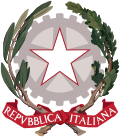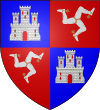Portal:Heraldry
Welcome to the Heraldry and Vexillology Portal!


Heraldry encompasses all of the duties of a herald, including the science and art of designing, displaying, describing and recording coats of arms and badges, as well as the formal ceremonies and laws that regulate the use and inheritance of arms. The origins of heraldry lie in the medieval need to distinguish participants in battles or jousts, whose faces were hidden by steel helmets.
Vexillology (from the Latin vexillum, a flag or banner) is the scholarly study of flags, including the creation and development of a body of knowledge about flags of all types, their forms and functions, and of scientific theories and principles based on that knowledge. Flags were originally used to assist military coordination on the battlefield, and have evolved into a general tool for signalling and identification, particularly identification of countries.
Selected biography

Sir John Vanbrugh (pronounced "Van'-bru") (January 24, 1664? – March 26, 1726) was an English dramatist, officer of arms and architect, perhaps best known as the designer of Blenheim Palace. He wrote two argumentative and outspoken Restoration comedies, The Relapse (1696) and The Provoked Wife (1697), which have become enduring stage favourites but originally occasioned much controversy.
Vanbrugh was in many senses a radical throughout his life. As a young man and a committed Whig, he was part of the scheme to overthrow James II, put William III on the throne and protect English parliamentary democracy, dangerous undertakings which landed him in the dreaded Bastille of Paris as a political prisoner. In his career as a playwright, he offended many sections of Restoration and 18th-century society, not only by the sexual explicitness of his plays, but also by their messages in defence of women's rights in marriage. He was attacked on both counts, and was one of the prime targets of Jeremy Collier's Short View of the Immorality and Profaneness of the English Stage. In his architectural career, he created what came to be known as English Baroque. His architectural work was as bold and daring as his early political activism and marriage-themed plays, and jarred conservative opinions on the subject. Vanbrugh also held the heraldic offices of Carlisle Herald and Clarenceux King of Arms. (more...)
Selected coat of arms

The emblem of Italy (Italian: emblema della Repubblica italiana) was adopted by the newly formed Italian Republic on 5 May 1948. Although often referred to as a coat of arms (or stemma in Italian), it is technically an emblem as it was not designed to conform to traditional heraldic rules. The emblem comprises a white five-pointed star, with a fine red border, superimposed upon a five-spoked cogwheel, standing between an olive branch to the dexter side and an oak branch to the sinister side; the branches are in turn bound together by a red ribbon with the inscription REPVBBLICA ITALIANA. The emblem is used extensively by the Italian government. The armorial bearings of the House of Savoy, blazoned gules a cross argent, were previously in use by the late Kingdom of Italy; the supporters, on either side a lion rampant Or, were replaced with fasci littori (literally bundles of the lictors) during the fascist era. (more...)
Selected flag

Throughout most of the history of Poland, the banner of Poland was one of the main symbols of the Polish State, normally reserved for use by the head of state. Although its design changed with time, it was generally a heraldic banner, i.e., one based directly on the national coat of arms: a crowned White Eagle on a red field (Gules an eagle Argent crowned Or). A national banner is not mentioned in the current (2007) regulations on Polish national symbols, although today's presidential jack is based directly on the pre-war design for the Banner of the Republic. (more...)
Selected picture

A lithograph from 1876, showing the seals of the then-47 U.S. states and territories as well as the District of Columbia. Some of these seals have changed since this image was created.
Did you know...
- ...that the triskelion (pictured) in MacLeod heraldry originates from a belief that the clan's founder, Leod, was a son of a king of Mann?
- ...that Yusak Pakage was sentenced to ten years in prison after raising the Morning Star flag?
- ...that merchant's marks, the precursors of hallmarks, printers' marks and modern-day trademarks, served in place of heraldic imagery, which could not be used by middle class traders and artisans?
- ...that the Duke of Cambridge's Personal Canadian Flag was first used during the 2011 royal tour of Canada?
- ...that in The Stages of Life, German painter Caspar David Friedrich depicted his son holding a Swedish flag because Friedrich considered himself half-Swedish?
Related portals
|
|
|
Heraldry Web resources
Authorities
- Belgium - The Council of Nobility, Flemish Heraldic Council and Council of Heraldry and Vexillology of the French Community
- Canada - Canadian Heraldic Authority and see also Public Register of Arms, Flags and Badges
- England, Wales, and Northern Ireland - The College of Arms
- Ireland - The Office of the Chief Herald of Ireland
- Netherlands - High Council of Nobility
- Portugal - Instituto da Nobreza Portuguesa
- Scotland - The Court of the Lord Lyon
- South Africa - South African Bureau of Heraldry
- Sweden - National Board of Heraldry, The National Archive
- United States Army - The United States Army Institute of Heraldry
Societies
- Greek Heraldry Society
- The Academy of Heraldic Science Czech republic
- The American College of Heraldry
- The American Heraldry Society
- The Augustan Society
- The Australian Heraldry Society Inc.
- Bulgarian Heraldry and Vexillology Society
- The Center for Research of Orthodox Monarchism
- Cambridge University Heraldic and Genealogical Society
- Chiltern Heraldry Group
- The College of Dracology
- Croatian Heraldic and Vexillologic Association
- The Finnish Heraldic Society
- Fryske Rie foar Heraldyk
- Hellenic Armigers Society
- Guild of Heraldic Artists
- Genealogical Society of Ireland
- Heraldry Research Institute (Japan)
- The Heraldry Society
- The Heraldry Society of Africa
- The Heraldry Society of New Zealand Inc.
- The Heraldry Society of Scotland
- The Heraldry Society of Southern Africa
- The Institute of Heraldic and Genealogical Studies
- The International Association of Amateur Heralds
- Italian Center of Vexillological Studies
- Lancashire Heraldry Group
- Macedonian Heraldry Society
- New England Historic Genealogical Society Committee on Heraldry
- Norwegian Heraldry Society
- Oxford University Heraldry Society
- Polish Heraldry Society
- Polish Nobility Confederation
- Real Academia Matritense de Heráldica y Genealogía - Royal Academy of Heraldry and Genealogy of Madrid
- Romanian Institute for Genealogy and Heraldry
- The Royal Heraldry Society of Canada
- The Russian College of HeraldryThe Russian College of Heraldry
- Serbian Heraldic Society
- Societas Heraldica Scandinavica
- Societas Heraldica Slovenica
- Swedish Heraldic Society
- Ukrainian Heraldry Society
- Royal Association Genealogical and Heraldic Office of Belgium
Vexillology
Software
- Coat of Arms Visual Designer web-based program
- Puncher Heraldry Program
- Blazonry Server - pyBlazon
- DrawShield - creates SVG shield or arms image from blazon
- CoaMaker - web-based tool
- Blazon95 and BLAZONS! 2000, older Windows applications
Texts
- Heraldry, historical and popular : with seven hundred illustrations (1863)
- A Complete Guide to Heraldry (1909)
Other
Wikimedia
The following Wikimedia Foundation sister projects provide more on this subject:
-
Commons
Free media repository -
Wikibooks
Free textbooks and manuals -
Wikidata
Free knowledge base -
Wikinews
Free-content news -
Wikiquote
Collection of quotations -
Wikisource
Free-content library -
Wikispecies
Directory of species -
Wikiversity
Free learning tools -
Wikivoyage
Free travel guide -
Wiktionary
Dictionary and thesaurus












